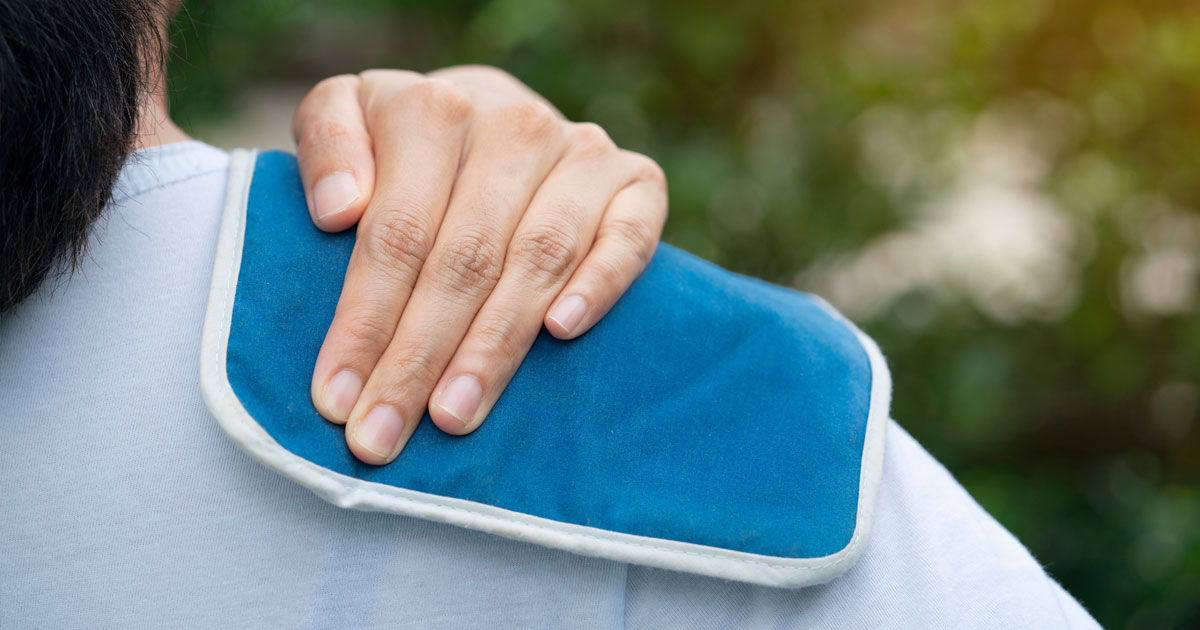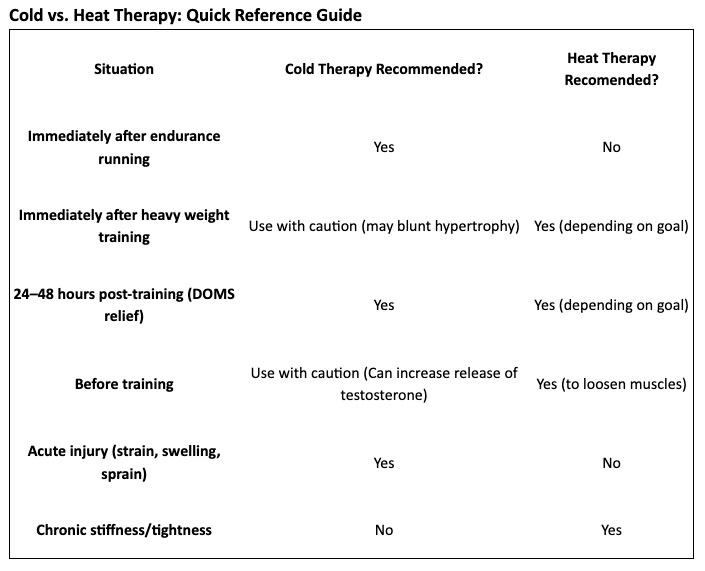
Cold Vs Heat Therapy
How to Use Them to Optimise Recovery and Adaptation After Running and Strength Training
Recovery and Adaptation
Cold and heat therapy are two widely used recovery tools, each offering unique benefits when applied correctly. However, knowing when (and when not) to use them is crucial for optimising not just recovery but long-term adaptation to training. Interestingly, while cold therapy, particularly ice baths, can be effective in reducing soreness and inflammation, some research suggests that using ice baths immediately after weight training might actually blunt muscle growth (hypertrophy). This highlights the importance of tailoring your recovery strategies to your goals. Let’s break down when to use cold vs. heat therapy to get the most out of your training and recovery.
Cold Therapy
Cold therapy, also known as cryotherapy, involves applying ice packs, cold baths, or even ice massages to sore muscles. The primary goal is to reduce inflammation and numb pain by constricting blood vessels and decreasing metabolic activity in the affected area.
Intentional cold immersion causes an increase in epinephrine (aka adrenaline) and norepinephrine (aka noradrenaline) release in the brain and body. It has also been shown to increase dopamine levels.
When to Use Cold Therapy?
- Immediately After Intense Exercise
If you’ve just finished a competition, long run, intense interval session or heavy contact training that can cause muscle strain or micro-tears, cold therapy can help minimize inflammation and swelling. - For Acute Injuries
If you experience a strain, sprain, or joint pain, applying ice within the first 24–48 hours can help manage swelling and prevent excessive tissue damage. - To Reduce Soreness (DOMS)
Delayed onset muscle soreness (DOMS) usually peaks 24–48 hours after a workout. Ice baths or cold compresses can help alleviate the soreness by reducing inflammation.
Cold Therapy & Hypertrophy
While ice baths can reduce soreness, emerging research suggests that using cold water immersion directly after resistance training may impair some of the cellular signalling pathways involved in muscle growth. Essentially, by reducing inflammation (a key driver of adaptation), you could potentially blunt hypertrophy if ice baths are overused after weight training.
A Note on Cold Therapy
Use cold therapy sparingly after strength training — perhaps reserving it for times when soreness is extreme or when performance in upcoming sessions takes priority over muscle growth.
For endurance training, cold therapy is generally less of a concern in terms of blunting adaptation and can be used more freely.
Heat Therapy
Heat therapy increases blood flow, promotes muscle relaxation, and can help with stiffness or chronic muscle tightness. Unlike cold therapy, which constricts blood vessels, heat therapy dilates them, bringing more oxygen and nutrients to tired muscles. Global heat exposure increases your heart rate and has many benefits for your cardiovascular health.
When to Use Heat Therapy?
- Before a Workout
Applying heat before a workout can loosen tight muscles and improve flexibility, reducing the risk of injury. - For Chronic Muscle Stiffness
If you experience ongoing muscle tightness from training, heat therapy can help improve blood flow and promote relaxation. - 24+ Hours After a Workout
If muscle soreness lingers beyond the initial inflammation phase, heat therapy can help loosen up tight muscles and accelerate recovery. - If unable to exercise
Heat exposure is not a replacement for exercise, but exposure to heat can be beneficial to those who can not partake in physical activity.
Guide For Use
Cold Therapy
- Cold Water Immersion (Ice Baths)
The colder the water, the less time you need to be in; even at 6°C or less for 60s can be effective. Taking a cold bath (Even as "warm as" 10–15°C) for 10–15 minutes can help reduce muscle soreness. - Ice Packs
Apply an ice pack wrapped in a cloth to sore areas for 15–20 minutes. - Contrast Therapy
Alternating between cold and hot treatments (e.g., 1-3 minutes of cold water followed by 1-3 minutes of warm water) can promote circulation and speed up recovery.
Heat Therapy
- Heating Pads
Apply a heating pad or warm towel to sore areas for 15–20 minutes. - Warm Baths
Soaking in a warm bath (33–38°C) can ease muscle stiffness and promote relaxation. - Sauna or Steam Rooms
These can help with overall circulation and relaxation after an intense workout. Heat exposure (5-20min) can trigger hormonal and physiological changes in our body such as Heat Shock Proteins which help reduce cellular damage, improving recovery and overall health.

Cold and heat therapy are valuable tools, but like any tool, they work best when used with intention.
If your primary goal is recovery for performance (e.g., preparing for back-to-back training sessions or competitions), cold therapy, including ice baths, can be highly effective in reducing soreness and inflammation, allowing you to perform at a higher level in the following sessions/competitions.
However, if your goal is to maximise muscle growth from resistance training, it may be wise to limit the use of cold therapy immediately post-workout to avoid potentially interfering with the muscle-building process. Simply delaying your cold exposure for 90min+ after weights may help you achieve your goals and prepare for your next session.
Heat therapy, on the other hand, is ideal for promoting relaxation, improving mobility, and supporting long-term recovery without negatively impacting adaptation. It can be a useful tool to aid recovery and "loosen you up" prior to training.
By understanding when and how to use these methods, you can take control of your recovery strategy, optimising not just how you feel day-to-day but how well your body adapts and progresses over time.
Do you want specific advice on when to use heat or cold therapy in your routine? Book an appointment with our practitioners today.